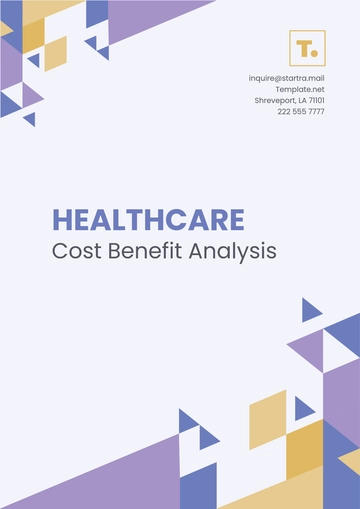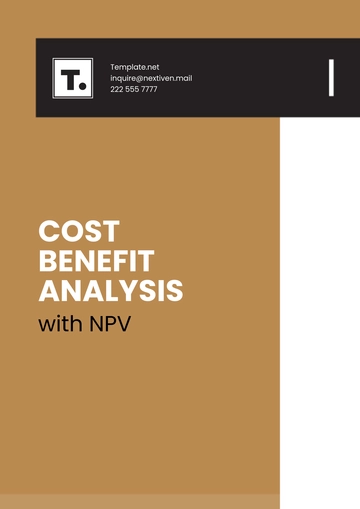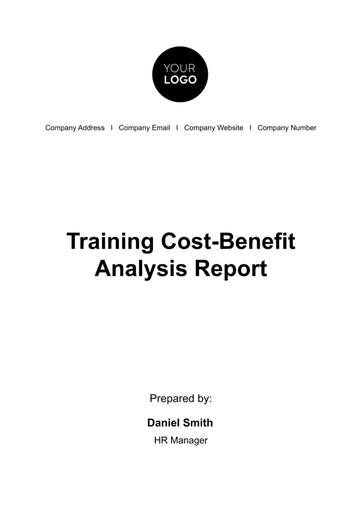Free Real Estate Rental Property Cash Flow Analysis

I. Property Information
The property under consideration is a multi-family residential building located at [Property Address]. It consists of four units, each comprising two bedrooms and one bathroom. The total square footage of the building is 3,600 square feet, with each unit averaging 900 square feet. Built in 1990, the property features modern amenities such as central air conditioning, updated kitchens, and on-site parking for tenants. Its location offers convenient access to public transportation, schools, and shopping centers, making it an attractive rental option for tenants seeking urban living accommodations.
II. Rental Income
Description | Monthly Income ($) | Annual Income ($) |
|---|---|---|
Base Rent | $8,000 | $96,000 |
Additional Income | $500 | $6,000 |
Total Gross Income | $8,500 | $102,000 |
Vacancy Rate: 5%
Vacancy Loss Calculation: $102,000 * 5% = $5,100
Total Gross Rental Income: $102,000 - $5,100 = $96,900
A. Monthly Rental Income
Monthly rental income refers to the revenue generated from leasing out the property to tenants. For example, in the case of a multi-family property with three units, each unit may be rented out at different rates. The base rent for each unit is listed along with any additional income sources such as parking fees or income from laundry facilities. These sources collectively contribute to the total monthly rental income for the property.
B. Vacancy Rate
The vacancy rate represents the percentage of time the property is expected to remain unoccupied and not generating rental income. Calculating the vacancy rate involves estimating the average duration of vacancies throughout the year. This estimate considers factors such as tenant turnover, market conditions, and the effectiveness of property management in filling vacancies promptly. The vacancy loss calculation accounts for potential revenue lost during vacant periods, allowing investors to adjust their expectations for rental income accordingly.
C. Total Gross Rental Income
The total gross rental income is derived by subtracting the vacancy loss from the total monthly rental income. This figure represents the total revenue generated by the property from rent and additional income sources over the course of a year. It serves as a key metric for evaluating the income potential of the rental property before accounting for expenses.
III. Operating Expenses
Operating expenses encompass the various costs associated with owning and maintaining the rental property.
Expense | Monthly ($) | Annual ($) |
|---|---|---|
Property Taxes | $600 | $7,200 |
Property Insurance | $150 | $1,800 |
Maintenance and Repairs | $500 | $6,000 |
Property Management Fees | $800 | $9,600 |
Utilities | $700 | $8,400 |
HOA Fees | $0 | $0 |
Other Operating Expenses | $200 | $2,400 |
Total Operating Expenses | $2,950 | $35,400 |
A. Property Taxes
Property taxes are taxes imposed by local governments based on the assessed value of the property. These taxes contribute to the overall expenses incurred by property owners and are typically paid on an annual basis. The property tax rate and assessed value of the property influence the amount of taxes owed, which is factored into the cash flow analysis.
B. Property Insurance
Property insurance provides coverage for potential risks such as damage to the property due to fire, theft, or natural disasters. The cost of property insurance premiums is included as an operating expense in the cash flow analysis. The insurance coverage and premiums may vary depending on factors such as the location, size, and condition of the property.
C. Maintenance and Repairs
Maintenance and repair expenses encompass the costs associated with regular upkeep and necessary repairs to maintain the property's condition. These expenses include routine maintenance tasks such as landscaping, cleaning, and minor repairs, as well as occasional larger expenses for repairs or replacements of structural components or systems within the property.
D. Property Management Fees
Property management fees are expenses incurred for professional property management services, which may include tasks such as tenant screening, rent collection, maintenance coordination, and financial reporting. Property management fees are typically calculated as a percentage of the property's rental income and are included in the cash flow analysis to reflect the cost of outsourcing property management responsibilities.
E. Utilities
Utilities expenses include the costs of providing essential services such as water, electricity, gas, and trash removal to the property. These expenses may be borne by the property owner or passed on to tenants through utility bill-back arrangements. Utilities costs are included as operating expenses in the cash flow analysis to accurately reflect the total expenses associated with owning and operating the rental property.
F. Homeowner Association (HOA) Fees
If the rental property is part of a homeowners association (HOA), HOA fees are included as operating expenses. These fees cover expenses related to shared amenities, common area maintenance, and community services provided by the HOA. HOA fees vary depending on the amenities and services provided by the association and are typically paid on a monthly or annual basis.
G. Other Operating Expenses
Other operating expenses may include miscellaneous costs not covered in the categories above, such as advertising expenses, legal fees, and administrative costs. These expenses are included in the cash flow analysis to provide a comprehensive overview of the total operating expenses associated with owning and operating the rental property.
IV. Capital Expenditures (CapEx)
Capital expenditures, also known as CapEx, are essentially a term used to describe the substantial expenses a company goes through. These substantial expenses are typically incurred during the process of either acquiring, improving, or replacing long-term assets within a specific property. These assets are often categorized as 'long-term' because they are not easily converted into cash and their benefits can typically be used over a long period of time.
Expense | Annual ($) |
|---|---|
Reserve for Major Repairs | $4,000 |
Renovations/Improvements | $3,000 |
Total CapEx | $7,000 |
V. Financing Costs
The term "financing costs" encompasses the various expenditures associated with securing and managing the financial means for a rental property. These costs are not limited to but often include mortgage loan payments, which are the monthly amounts paid to diminish the direct loan taken for the purchase of the property. They also comprise interest expenses - additional charges that are applied to the principal loan amount. Another critical element of financing costs is loan origination fees. These are upfront charges that a lender imposes to process a new loan application, used as compensation for putting the loan in place and performing the requisite tasks such as document preparation and credit checks.
Expense | Monthly ($) | Annual ($) |
|---|---|---|
Mortgage Loan Payment | $2,200 | $26,400 |
Interest Expense | $1,200 | $14,400 |
Loan Origination Fees | $0 | $0 |
Other Financing Costs | $0 | $0 |
Total Financing Costs | $3,400 | $40,800 |
VI. Property Management Costs
The costs associated with property management cover the various expenses that arise when engaging the services of a professional company specialized in property management. This company is generally tasked with overseeing the routine operations of a rental property, ensuring that things run smoothly every day.
Expense | Monthly ($) | Annual ($) |
|---|---|---|
Monthly Management Fee | $800 | $9,600 |
Leasing Fees | $200 | $2,400 |
Maintenance Coordination | $0 | $0 |
Total Management Costs | $1,000 | $12,000 |
VII. Taxes
Expense | Annual ($) |
|---|---|
Property Taxes | $7,200 |
Income Taxes (est.) | $10,000 |
Total Taxes | $17,200 |
A. Property Taxes
The estimated value of property taxes for the given property address is approximately $2,500 every year. It is the local government that imposes these taxes, basing the amount each property owner needs to pay on the assessed value of their specific piece of real estate. The collected revenues from these property taxes play a significant role in funding valuable public services and the necessary infrastructure, such as roads, hospitals, and schools, that maintain the welfare and functioning of the community.
B. Income Taxes
While property taxes are accounted for in the cash flow analysis, income taxes on rental income may also apply. It's important for investors to consult with a tax advisor to determine the tax implications of rental income and any deductions or credits they may be eligible for based on their individual tax situation.
VIII. Cash Flow Calculation
Description | Annual ($) |
|---|---|
Total Gross Rental Income | $96,900 |
Total Operating Expenses | -$35,400 |
Total Financing Costs | -$40,800 |
Total Management Costs | -$12,000 |
Total Taxes | -$17,200 |
Net Operating Income (NOI) | $8,500 |
Cash Flow Before Taxes: $8,500
Cash-on-Cash Return: ($8,500 / $150,000) * 100% = 5.67%
Return on Investment (ROI): ($8,500 / $150,000) * 100% = 5.67%
A. Total Rental Income: Calculated as the sum of base rent and any additional income, such as parking fees, totaling $1,600 per month.
B. Total Operating Expenses: Including property taxes, insurance, maintenance, utilities, property management fees, and other expenses, totaling $750 per month.
C. Total Financing Costs: Comprising mortgage loan payments and interest expenses, totaling $900 per month.
D. Total Property Management Costs: Reflecting monthly management fees, totaling $120 per month.
E. Total Taxes: Consisting of property taxes, estimated at $208.33 per month.
F. Net Operating Income (NOI): Calculated as total rental income minus total operating expenses, totaling $829.67 per month.
G. Cash Flow Before Taxes: Representing the surplus cash flow after deducting financing costs, property management costs, and taxes from total rental income, totaling $482.67 per month.
IX. Cash-on-Cash Return
Definition: Cash-on-Cash Return measures the annual return on investment relative to the amount of cash invested in the property.
Calculation: Cash Flow Before Taxes divided by Total Cash Investment.
Example: Assuming a total cash investment of $50,000, the Cash-on-Cash Return would be calculated as follows:
Cash Flow Before Taxes ($482.67 per month * 12 months) = $5,792.04 per year
Cash-on-Cash Return = $5,792.04 / $50,000 = 11.58%
Interpretation: A Cash-on-Cash Return of 11.58% indicates that for every dollar invested in the property, the investor can expect to earn approximately 11.58 cents in annual cash flow.
X. Return on Investment (ROI)
Definition: Return on Investment (ROI) measures the profitability of an investment relative to its cost.
Calculation: Net Operating Income (NOI) divided by Total Cash Investment.
Example: Using the same assumptions as above, the ROI would be calculated as follows:
Net Operating Income (NOI) = $829.67 per month * 12 months = $9,956.04 per year
ROI = $9,956.04 / $50,000 = 19.91%
Interpretation: An ROI of 19.91% indicates that the investment generates approximately $0.1991 in profit for every dollar invested, providing insight into the overall profitability of the property.
XI. Break-Even Analysis
Definition: Break-Even Analysis determines the occupancy rate at which the property's rental income equals its total expenses.
Calculation: Break-Even Occupancy Rate = (Total Operating Expenses + Total Financing Costs) / Total Rental Income
Example: Using the previously calculated figures:
Total Operating Expenses + Total Financing Costs = $750 + $900 = $1,650 per month
Break-Even Occupancy Rate = $1,650 / $1,600 = 103.13%
Interpretation: In this example, the break-even occupancy rate exceeds 100%, indicating that the property must be occupied for more than 100% of the time to cover all expenses solely through rental income. This analysis helps investors understand the property's sensitivity to vacancy rates and adjust their investment strategies accordingly.
XII. Sensitivity Analysis
Definition: Sensitivity Analysis evaluates how changes in key variables, such as rent, expenses, and vacancy rates, impact the property's cash flow and financial performance.
Method: Adjust one variable at a time while keeping others constant to assess its effect on cash flow and investment returns.
Example: Assess the impact of a 10% increase in rental income on cash flow and ROI.
Interpretation: A sensitivity analysis provides insights into the property's resilience to market fluctuations and helps investors identify potential risks and opportunities. By understanding how changes in variables affect cash flow and returns, investors can make informed decisions to mitigate risks and maximize profitability.
XIII. Conclusion
Summary of Cash Flow Analysis
The Real Estate Rental Property Cash Flow Analysis offers a detailed examination of the property's financial performance, encompassing its income, expenses, and net cash flow. By meticulously analyzing each component, from rental income to operating expenses, the analysis provides a comprehensive snapshot of the property's financial health.
Investment Recommendations
Given the positive cash flow generated by the property, with a robust Net Operating Income (NOI) of $829.67 per month and a Cash Flow Before Taxes of $482.67 per month, it is recommended to proceed with the investment. These figures suggest that the property has the potential to provide steady income streams and serve as a profitable investment vehicle for the investor.
Assessment of Return Metrics
The calculated Cash-on-Cash Return of 11.58% and Return on Investment (ROI) of 19.91% indicate attractive returns relative to the total cash investment. These metrics demonstrate the property's ability to generate significant returns on the capital deployed, highlighting its investment viability and potential for wealth accumulation.
Risk Management Considerations
While the break-even analysis underscores the property's sensitivity to occupancy rates, it also emphasizes the importance of maintaining high occupancy levels to cover expenses and ensure profitability. By proactively managing vacancy risks and implementing effective tenant acquisition and retention strategies, investors can mitigate potential risks and safeguard their investment.
Strategic Insights
The sensitivity analysis provides valuable insights into the property's resilience to market fluctuations, enabling investors to anticipate and adapt to changing conditions effectively. Armed with this strategic foresight, investors can make informed decisions, adjust their investment strategies as needed, and capitalize on emerging opportunities to maximize returns and achieve their financial goals.
- 100% Customizable, free editor
- Access 1 Million+ Templates, photo’s & graphics
- Download or share as a template
- Click and replace photos, graphics, text, backgrounds
- Resize, crop, AI write & more
- Access advanced editor
Discover the ultimate tool for savvy real estate investors on Template.net. Our Real Estate Rental Property Cash Flow Analysis Template offers an editable and customizable solution to assess your property's financial health. With our intuitive AI Editor Tool, effortlessly analyze income, expenses, and returns to make informed investment decisions. Maximize profits with precision and ease.





























